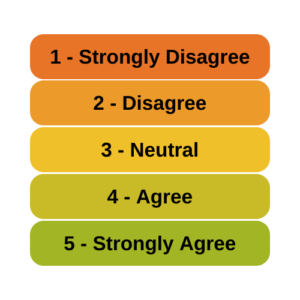There are not a lot of statistical methods designed just to analyze ordinal variables.
But that doesn’t mean that you’re stuck with few options. There are more than you’d think.
Some are better than others, but it depends on the situation and research questions.
Here are five options when your dependent variable is ordinal.
(more…)
A very common question is whether it is legitimate to use Likert scale data in parametric statistical procedures that  require interval data, such as Linear Regression, ANOVA, and Factor Analysis.
require interval data, such as Linear Regression, ANOVA, and Factor Analysis.
A typical Likert scale item has 5 to 11 points that indicate the degree of something. For example, it could measure agreement with a statement, such as 1=Strongly Disagree to 5=Strongly Agree. It can be a 1 to 5 scale, 0 to 10, etc. (more…)
When your dependent variable is not continuous, unbounded, and measured on  an interval or ratio scale, linear models don’t fit. The data just will not meet the assumptions of linear models. But there’s good news, other models exist for many types of dependent variables.
an interval or ratio scale, linear models don’t fit. The data just will not meet the assumptions of linear models. But there’s good news, other models exist for many types of dependent variables.
Today I’m going to go into more detail about 6 common types of dependent variables that are either discrete, bounded, or measured on a nominal or ordinal scale and the tests that work for them instead. Some are all of these.
(more…)

Interpreting the results of logistic regression can be tricky, even for people who are familiar with performing different kinds of statistical analyses. How do we then share these results with non-researchers in a way that makes sense?
(more…)
A great tool to have in your statistical tool belt is logistic regression.
It comes in many varieties and many of us are familiar with the variety for binary outcomes.
But multinomial and ordinal varieties of logistic regression are also incredibly useful and worth knowing.
They can be tricky to decide between in practice, however. In some — but not all — situations you (more…)
When a model has a binary outcome, one common effect size is a risk ratio. As a reminder, a risk ratio is simply a ratio of two probabilities. (The risk ratio is also called relative risk.)
Risk ratios are a bit trickier to interpret when they are less than one.
A predictor variable with a risk ratio of less than one is often labeled a “protective factor” (at least in Epidemiology). This can be confusing because in our typical understanding of those terms, it makes no sense that a risk be protective.
So how can a RISK be protective? (more…)


